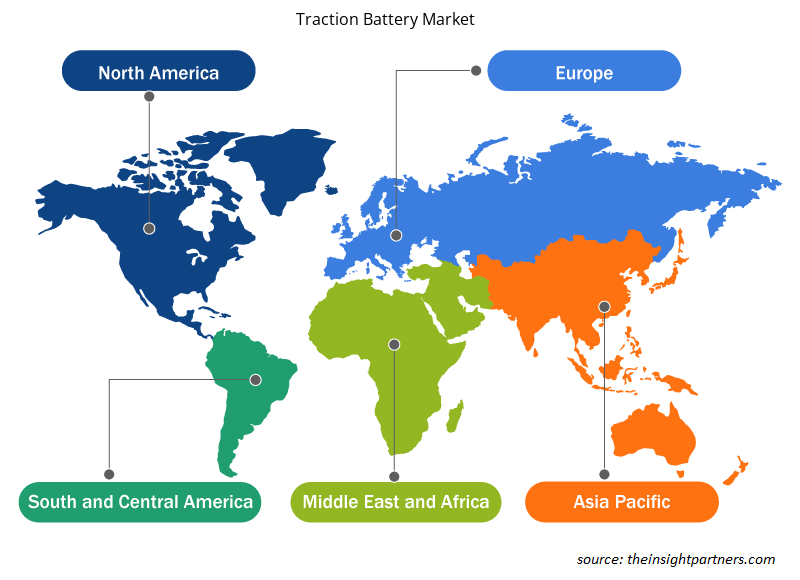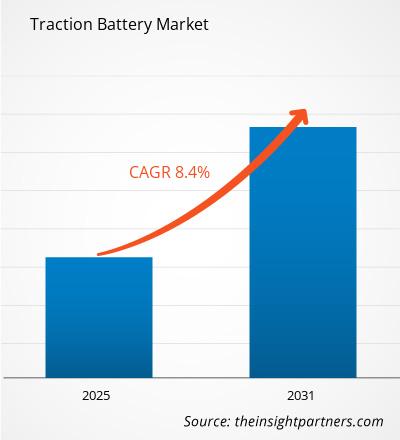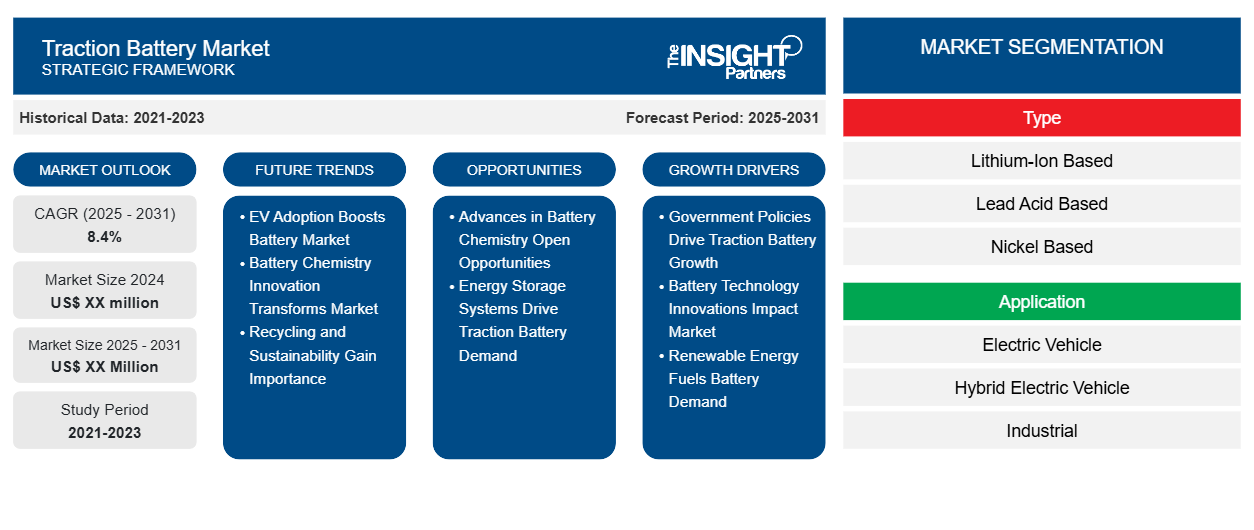Se espera que el mercado de baterías de tracción registre una CAGR del 8,4 % entre 2024 y 2031, con un tamaño de mercado que se expandirá de US$ XX millones en 2024 a US$ XX millones en 2031.CAGR of 8.4% from 2024 to 2031, with a market size expanding from US$ XX million in 2024 to US$ XX Million by 2031.
El informe de mercado de baterías de tracción cubre el análisis por tipo (basado en iones de litio, basado en ácido de plomo, basado en níquel, otros); aplicación (vehículo eléctrico (EV), vehículo eléctrico híbrido (HEV), industrial, otros) y geografía (América del Norte, Europa, Asia Pacífico y América del Sur y Central).
Propósito del Informe
El informe sobre el mercado de baterías de tracción de The Insight Partners tiene como objetivo describir el panorama actual y el crecimiento futuro, los principales factores impulsores, los desafíos y las oportunidades. Esto proporcionará información a diversas partes interesadas del negocio, como:
- Proveedores/fabricantes de tecnología: Para comprender la dinámica cambiante del mercado y conocer las oportunidades potenciales de crecimiento, lo que les permitirá tomar decisiones estratégicas informadas.
- Inversionistas: Realizar un análisis exhaustivo de tendencias sobre la tasa de crecimiento del mercado, las proyecciones financieras del mercado y las oportunidades que existen en toda la cadena de valor.
- Órganos reguladores: Regular las políticas y vigilar las actividades del mercado con el objetivo de minimizar los abusos, preservar la confianza de los inversores y defender la integridad y estabilidad del mercado.
Segmentación del mercado de baterías de tracción
Tipo
- Basado en iones de litio
- A base de plomo-ácido
- A base de níquel
Solicitud
- Vehículo eléctrico
- Vehículo eléctrico híbrido
- Industrial
Personalice este informe según sus necesidades
Obtendrá personalización en cualquier informe, sin cargo, incluidas partes de este informe o análisis a nivel de país, paquete de datos de Excel, así como también grandes ofertas y descuentos para empresas emergentes y universidades.
-
Obtenga las principales tendencias clave del mercado de este informe.Esta muestra GRATUITA incluirá análisis de datos, desde tendencias del mercado hasta estimaciones y pronósticos.
Factores impulsores del crecimiento del mercado de baterías de tracción
- Las políticas gubernamentales impulsan el crecimiento de las baterías de tracción: el crecimiento se ve impulsado por el transporte sostenible, como resultado de las políticas gubernamentales y el estímulo a los consumidores para que compren vehículos eléctricos, junto con las enormes inversiones de los fabricantes en I+D sobre tecnología de baterías. Por lo tanto, el mercado mundial de baterías de tracción crecerá considerablemente, con un marcado aumento de la cuota de mercado de las baterías de iones de litio.
- Las innovaciones en tecnología de baterías tienen un gran impacto en el mercado: Las innovaciones en tecnología de baterías tienen un gran impacto en el mercado de baterías de tracción. Los avances evolucionaron para generar mejoras en la eficiencia, aumento de la capacidad y una vida útil más prolongada. Por su parte, las baterías de iones de litio y las baterías de estado sólido avanzadas desarrolladas prometen un aumento de la densidad energética del 20 al 30 %, lo que conduce a una mayor autonomía de los vehículos. No solo impulsan las tendencias del mercado, sino que también crean ventajas competitivas para los fabricantes.
- Las energías renovables impulsan la demanda de baterías: las fuentes de energía renovable han sido la fuerza impulsora del mercado de baterías de tracción, en particular en términos de sistemas de almacenamiento de energía en energía solar y eólica. Con el tiempo, el consumo mundial de energía aumenta, lo que exige soluciones de almacenamiento de energía más eficientes y confiables. Para ir al grano, se prevé que solo el mercado de almacenamiento de energía alcance los 26 mil millones de dólares para 2030, y la mayor parte de ese dinero se destinará principalmente a baterías de tracción. Este crecimiento de los mercados está acompañado por la transformación hacia una energía más sostenible y una expansión de la visión general del mercado total, lo que destaca el importante papel de las baterías en la transición energética.
Tendencias futuras del mercado de baterías de tracción
- La adopción de vehículos eléctricos impulsa el mercado de baterías: la adopción de vehículos eléctricos ha impulsado la demanda de baterías de tracción. Hasta la fecha, se han vendido 13 millones de vehículos eléctricos en todo el mundo. De cara al futuro, las proyecciones muestran que para 2030, esa cifra podría alcanzar los 40 millones. La demanda obliga a una mayor producción e innovación en tecnologías con actores clave. Cabe destacar que el análisis FODA destacó las fortalezas en los avances tecnológicos; sin embargo, indicó que algunas de las amenazas que se planteaban a la dinámica y las estrategias del mercado eran los costos fluctuantes de las materias primas.
- La innovación en la química de las baterías transforma el mercado: La innovación en la química de las baterías está transformando el panorama de las baterías de tracción. Las empresas están buscando alternativas como las baterías de estado sólido y de litio-azufre, que prometen una mayor densidad energética y seguridad. En 2022, las baterías de estado sólido presentaron un aumento de más del 50% en la densidad energética con respecto a las baterías de iones de litio tradicionales. Un análisis PEST sugiere que los cambios tecnológicos están bajo presión debido a la regulación de soluciones más limpias, de ahí una competencia cada vez mayor entre los actores clave que adoptan la próxima generación de soluciones de baterías.
- El reciclaje y la sostenibilidad cobran importancia: el crecimiento del mercado de baterías de tracción pone de relieve el reciclaje y la sostenibilidad. El mercado de reciclaje de baterías de iones de litio alcanzará los 22.000 millones de dólares en 2030. Esta tendencia mejora la eficiencia de los recursos y ofrece respuestas a los problemas medioambientales. Los actores están cambiando su dinámica de mercado a medida que adoptan estrategias que se centran en prácticas sostenibles. Un análisis FODA señala oportunidades para el reciclaje, pero también señala desafíos como las brechas tecnológicas en el procesamiento de la química compleja de las baterías.
Oportunidades de mercado para baterías de tracción
- Los avances en la química de las baterías abren oportunidades: los rápidos avances en la química de las baterías, incluida la aparición de las baterías de estado sólido y de litio-azufre, abren las puertas al éxito definitivo de los fabricantes de baterías de tracción. Los informes de la industria sugieren que se espera que la densidad energética aumente más del 50% en 2025 debido a esta mejora en la tecnología de las baterías de estado sólido. Esta innovación no solo mejora el rendimiento, sino que también forma parte del análisis competitivo de todo el panorama de la industria. Por lo tanto, la oportunidad de crecimiento para las empresas se puede aprovechar invirtiendo en I+D y en asociaciones estratégicas para construir posiciones de mercado en todas las geografías.
- Los sistemas de almacenamiento de energía impulsan la demanda de baterías de tracción: los sistemas de almacenamiento de energía son un área en la que la necesidad de fuentes de energía renovables crea una oportunidad muy fuerte para los sistemas de baterías de tracción. Las inversiones en ESS en todo el mundo superaron los 25 mil millones de dólares en 2021, lo que demuestra el potencial de esta industria. En regiones como América del Norte, donde se están realizando esfuerzos para estabilizar su red y, al mismo tiempo, incorporar recursos renovables, las baterías de tracción formarán parte de esta revolución. Las empresas pueden sumarse a esta ola de crecimiento si se preparan para el futuro con tecnologías de baterías avanzadas y diversificación geográfica.
Perspectivas regionales del mercado de baterías de tracción
Los analistas de Insight Partners explicaron en detalle las tendencias y los factores regionales que influyen en el mercado de baterías de tracción durante el período de pronóstico. Esta sección también analiza los segmentos y la geografía del mercado de baterías de tracción en América del Norte, Europa, Asia Pacífico, Oriente Medio y África, y América del Sur y Central.

- Obtenga los datos regionales específicos para el mercado de baterías de tracción
Alcance del informe de mercado de baterías de tracción
| Atributo del informe | Detalles |
|---|---|
| Tamaño del mercado en 2024 | XX millones de dólares estadounidenses |
| Tamaño del mercado en 2031 | US$ XX millones |
| Tasa de crecimiento anual compuesta (CAGR) global (2025-2031) | 8,4% |
| Datos históricos | 2021-2023 |
| Período de pronóstico | 2025-2031 |
| Segmentos cubiertos |
Por tipo
|
| Regiones y países cubiertos |
América del norte
|
| Líderes del mercado y perfiles de empresas clave |
|
Densidad de actores del mercado de baterías de tracción: comprensión de su impacto en la dinámica empresarial
El mercado de baterías de tracción está creciendo rápidamente, impulsado por la creciente demanda de los usuarios finales debido a factores como la evolución de las preferencias de los consumidores, los avances tecnológicos y una mayor conciencia de los beneficios del producto. A medida que aumenta la demanda, las empresas amplían sus ofertas, innovan para satisfacer las necesidades de los consumidores y aprovechan las tendencias emergentes, lo que impulsa aún más el crecimiento del mercado.
La densidad de actores del mercado se refiere a la distribución de las empresas o firmas que operan dentro de un mercado o industria en particular. Indica cuántos competidores (actores del mercado) están presentes en un espacio de mercado determinado en relación con su tamaño o valor total de mercado.
Las principales empresas que operan en el mercado de baterías de tracción son:
- Corporación Toshiba
- Controles Johnson
- Industrias Exide Ltd.
- Baterias BAE GmbH
- Hitachi
Descargo de responsabilidad : Las empresas enumeradas anteriormente no están clasificadas en ningún orden particular.

- Obtenga una descripción general de los principales actores clave del mercado de baterías de tracción
Puntos de venta clave
- Cobertura integral: el informe cubre de manera integral el análisis de productos, servicios, tipos y usuarios finales del mercado de baterías de tracción, proporcionando un panorama holístico.
- Análisis de expertos: el informe se compila sobre la base de un profundo conocimiento de expertos y analistas de la industria.
- Información actualizada: El informe asegura relevancia comercial debido a su cobertura de información reciente y tendencias de datos.
- Opciones de personalización: este informe se puede personalizar para satisfacer los requisitos específicos del cliente y adaptarse adecuadamente a las estrategias comerciales.
Por lo tanto, el informe de investigación sobre el mercado de baterías de tracción puede ayudar a abrir camino para descifrar y comprender el escenario de la industria y las perspectivas de crecimiento. Si bien puede haber algunas preocupaciones válidas, los beneficios generales de este informe tienden a superar las desventajas.
- Análisis histórico (2 años), año base, pronóstico (7 años) con CAGR
- Análisis PEST y FODA
- Tamaño del mercado, valor/volumen: global, regional y nacional
- Industria y panorama competitivo
- Conjunto de datos de Excel
Informes relacionados
Testimonios
Razón para comprar
- Toma de decisiones informada
- Comprensión de la dinámica del mercado
- Análisis competitivo
- Información sobre clientes
- Pronósticos del mercado
- Mitigación de riesgos
- Planificación estratégica
- Justificación de la inversión
- Identificación de mercados emergentes
- Mejora de las estrategias de marketing
- Impulso de la eficiencia operativa
- Alineación con las tendencias regulatorias























 Obtenga una muestra gratuita para - Mercado de baterías de tracción
Obtenga una muestra gratuita para - Mercado de baterías de tracción